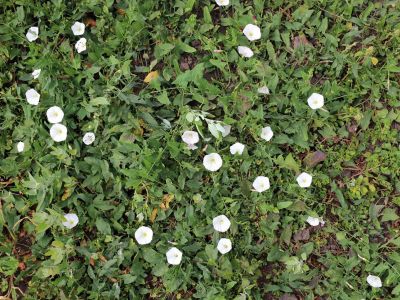Morning glory weed control in the cultivated landscape, however, is essential to prevent the plant from taking over.
Morning Glory vs. Bindweeds
Morning glory belongs to a family of unique and tenacious plants called Ipomoea. It is very closely related to the Convolvulus, or bindweed plants, which are perennial. Morning glory vine is an annual but reseeds itself so successfully you really wouldn’t know it. The bindweed plants grow from rhizomes, or underground storage structures that promote the spread of the weed. They are hardy and tenacious, opportunistic weeds that get into cracks and crevasses and are nearly impossible to remove. Many gardeners classify morning glory bindweeds as one type of plant. On the contrary, their separate taxonomy and growth patterns clearly identify the two as very different plants with similar flowers.
Morning Glory Vine Info
Another difference between morning glory and bindweed is the availability of the annual seeds and lack of access to bindweed seeds. Who would want to grow a weed that can visibly grow in a day, spreads over almost any surface, and doesn’t die unless you apply chemicals? Morning glory is more accommodating and the seeds are widely available in a host of colors. The slender stems grow rapidly and twist around each other for support. Flowers are funnel shaped, sometimes with a deeper or lighter throat. Garden supply centers carry the plant in pink, rose, purple, lavender, and white. The name morning glory vine stems from the flowers’ habit of opening in the first rays of morning light, and closing when the full heat and sun of the day arrive. Morning glory weeds in gardens are useful as groundcovers, natural décor for fences and barriers, and beautifiers for that broken shed or barn that you still haven’t removed. Do be cautious where you plant this vine though, as it grows with an uncanny speed and can be very invasive and difficult to remove.
How to Kill Morning Glory
Many gardeners are confused and call morning glory bindweeds. While the plants are separate species, they do have similar stubborn growth habits and are difficult to eradicate just with pulling. Morning glory weed control is a multi-part task. Pre-emergent herbicides will not work on this plant and pulling is labor intensive and tends to just break the vine, which may even re-sprout. Completely removing the plants can be a maddening, many years long task. The use of thick mulches or weed barrier fabric can help smother the seedlings in spring. Do not allow the vines to flower and set seed to prevent some of the sprouts the following spring. Systemic and broad leaf herbicides have some effect, but you need to spray early in the season when the plants are young. Painting it on the leaves helps prevent drift and surrounding plant injury. You will need to be vigilant and monitor for new plants and treat them. Controlling morning glory will take several seasons, and persistent seeds in soil can sprout years later. Morning glory vine can be a glory in the garden, but it can also be a royal pain, so think once and twice before you install this rampant colorful vine. Note: Chemical control should only be used as a last resort, as organic approaches are safer and much more environmentally friendly.
